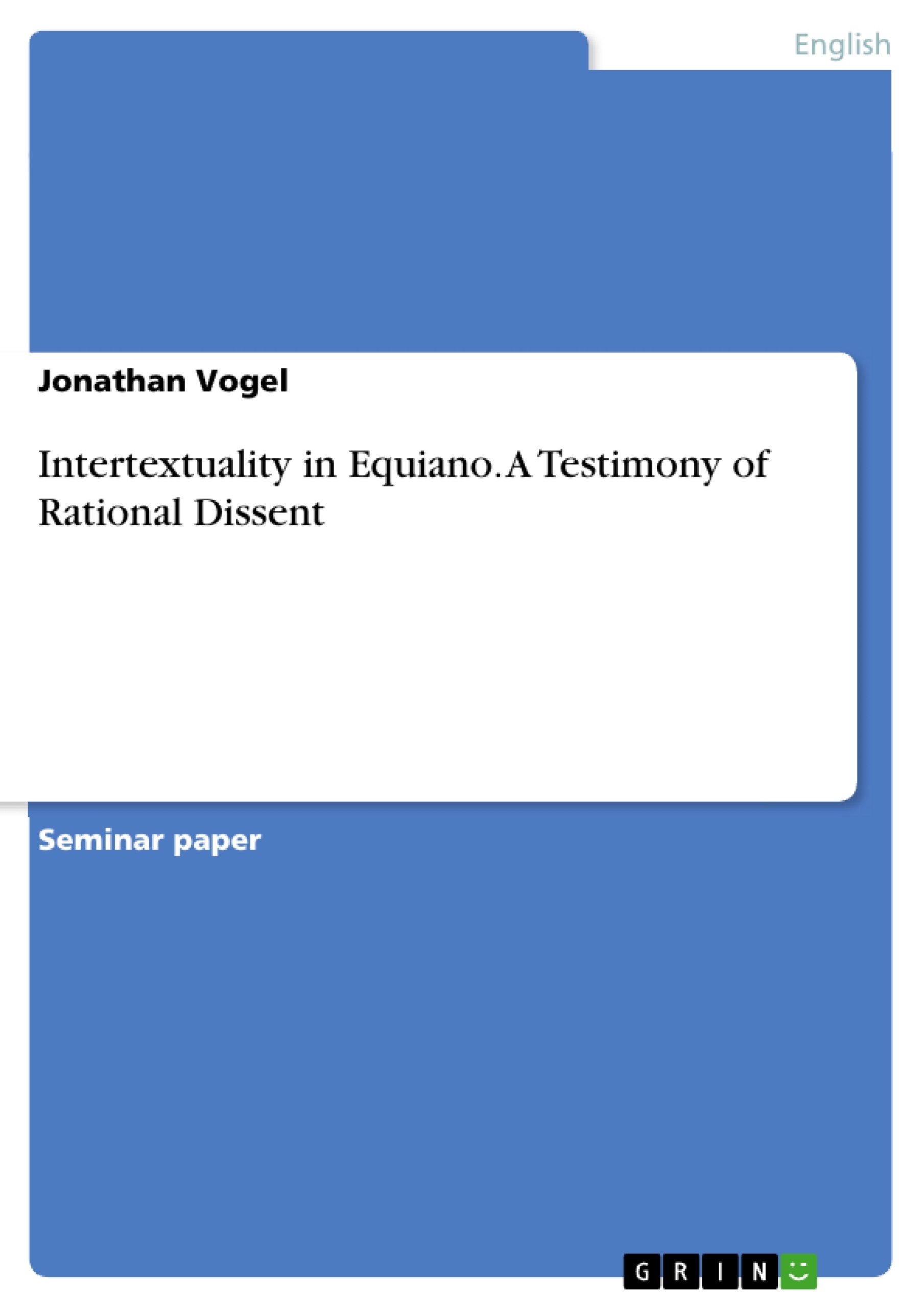At a time when morality has been increasingly separated from the aspect of the supernatural and placed within the human being himself, far and foremost by philosophers like Jean-Jacque Rousseau, Equiano tries to connect these two strands of thought. He combines religious and enlightened ideals in order to form one coherent moral argument against the toleration of slavery. In this paper, I will analyse how intertextual elements, more specifically explicit single-text references, are implemented by the author and how this can provide clarification on how Equiano is able to unite these two, actually opposing, world views in his argumentation.
“Man was born free, and he is everywhere in chains. Those who think themselves the masters of others are indeed greater slaves than they.” Although Olaudah Equiano would probably have agreed to this statement and many other ideas by Rousseau, he would not have quoted the French philosopher and forerunner of the Enlightenment in his Interesting Narrative.
If one were to arrange the individual years of human history according to the weight of the historical events, the year 1789 would be assigned a special significance. The worldwide sense of mission of the values of the French Revolution and the Déclaration des Droits de l'homme et du Citoyen mark the culmination of an era in which the understanding of humanity and what it means to be human was redefined. These maxims were the result of “the assurance of a universal sense of right and wrong” and the conviction that “the individual's right to happiness” (Gura) was men's greatest purpose. Moreover, this body of thought was detached from the connection to a supernatural being, but was rather based on a “reliance on human sympathy or ‘sentiment’ as the catalyst for moral choice” and “encouraged the belief that each individual had the power to control his or her own destiny” (Gura). The time was marked by a philosophical shift from “rigid theology” to “the values of Deism and moral naturalism” (Ruland & Bradbury). Therefore, people “were less interested in the metaphysical verities of introspective divines than in the progress of ordinary individuals, relating now to their fellow beings through emotions and experiences they shared” (Gura).
Inhaltsverzeichnis (Table of Contents)
- Introduction
- 1.1 Puritanism and Enlightenment
- 1.2 Intertextuality
- 2. Analysis
- 2.1 Biblical Elements - Authority and Authenticity
- 2.2 Travelogues - Borrowing from Influential Works
- 2.3 Thomas Clarkson and the Friends of Abolition
- 2.4 Rational Dissent
- 2.5 Between Evangelicalism and Enlightenment
- 3. Conclusion
Zielsetzung und Themenschwerpunkte (Objectives and Key Themes)
This paper analyzes Olaudah Equiano's The Interesting Narrative, focusing on how the author employs intertextuality, particularly explicit single-text references, to argue against the institution of slavery. The paper explores how Equiano combines religious and enlightened ideals to form a coherent moral argument. It examines how these intertextual elements contribute to the unification of seemingly opposing worldviews within Equiano's argumentation.
- The intersection of Puritanism and Enlightenment thought in Equiano's work.
- The role of intertextuality in shaping Equiano's arguments against slavery.
- The analysis of explicit single-text references from various genres and historical periods.
- The socio-political implications of Equiano's intertextual choices.
- Equiano's use of intertextuality to create a coherent argument against slavery.
Zusammenfassung der Kapitel (Chapter Summaries)
The introduction establishes the context of Equiano's work, highlighting the transition from Puritanism to Enlightenment during the late 18th century. It discusses the impact of the French Revolution and its ideals on the understanding of human rights and the growing movement against slavery. The introduction also introduces the concept of intertextuality and its importance in Equiano's narrative.
Chapter 1.1 delves into the contrasting influences of Puritanism and Enlightenment on Equiano's thought. It analyzes how Equiano combines elements of both philosophies, particularly the emphasis on individual morality and the importance of divine intervention in his argument against slavery. The chapter discusses how his work stands as a bridge between these two historical and philosophical frameworks.
Chapter 1.2 further explores the concept of intertextuality, defining it as a complex interplay between texts and their various references. The chapter examines the different interpretations of intertextuality, highlighting its function as a tool for communication and its socio-political implications. It discusses how Equiano's intertextual choices contribute to the construction of a persuasive and socially relevant argument.
Chapter 2, divided into five sub-sections, focuses on the specific intertextual elements found in The Interesting Narrative. It examines Equiano's use of biblical references, travelogues, works against slavery, and other literary and non-literary sources to support his arguments against the moral and social injustices of slavery.
Schlüsselwörter (Keywords)
Key terms and concepts explored in this paper include: intertextuality, Puritanism, Enlightenment, slavery, abolitionism, religious and enlightened ideals, moral argumentation, single-text references, biblical allusions, travelogues, social injustice, and socio-political context.
- Quote paper
- Jonathan Vogel (Author), 2023, Intertextuality in Equiano. A Testimony of Rational Dissent, Munich, GRIN Verlag, https://www.grin.com/document/1405037




